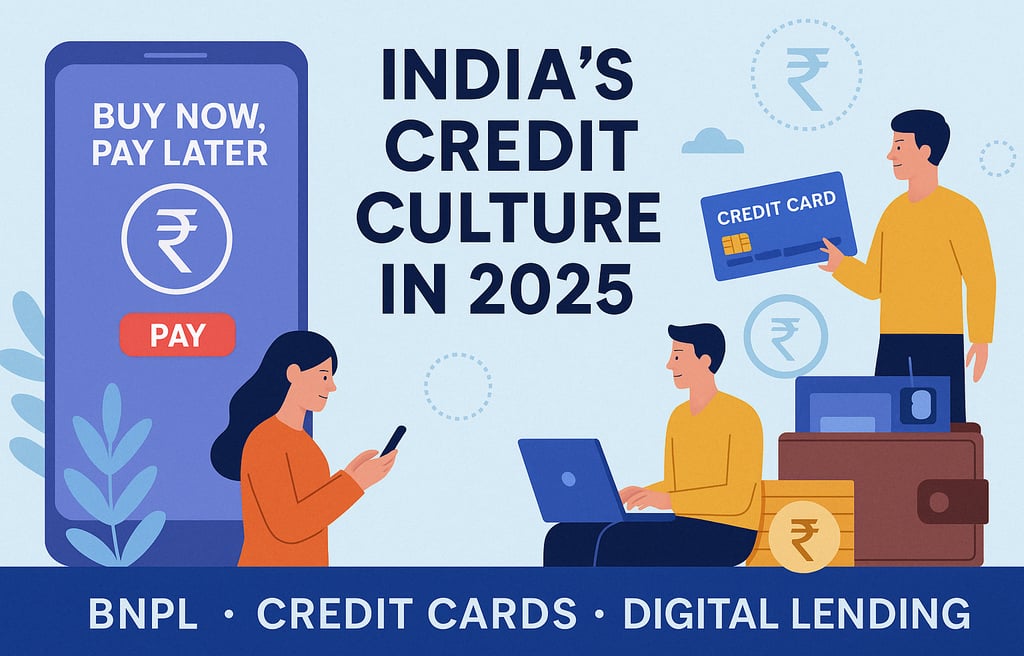Credit Culture in India: From Buy Now Pay Later to Credit Cards — Are We Overspending?
4/16/20254 min read


India’s Credit Culture in 2025: From Buy Now Pay Later to Credit Cards — Are We Overspending?
India’s relationship with credit has undergone a dramatic transformation in the last decade (credit culture in India). In 2025, the rise of Buy Now Pay Later (BNPL) services, increasing credit card penetration, and the rapid expansion of digital lending platforms have reshaped how Indians approach personal finance. While access to credit has improved financial inclusion and consumption, it has also raised a crucial question—are we borrowing more than we can afford?
This blog explores the evolution of India’s credit culture, the risks it presents, and what consumers and regulators must consider in this new financial environment.
The Changing Face of Credit in India
Historically, Indian households have been conservative in their approach to debt. Credit was used sparingly and largely for essentials—home loans, education, or emergencies. However, post-pandemic digitization, fintech expansion, and lifestyle shifts have created a new wave of credit behavior.
By 2025, more than 100 million Indians use credit instruments monthly. The average age of first-time borrowers has dropped, with Gen Z and young professionals actively embracing credit for lifestyle spending. Furthermore, credit usage has extended beyond Tier 1 cities to Tier 2 and Tier 3 towns, signaling a cultural shift in financial attitudes.
The Rise of Buy Now Pay Later (BNPL)
Among the most disruptive forces in the credit ecosystem is Buy Now Pay Later. BNPL allows users to purchase products immediately and defer payment without interest for a limited period. Offered by fintech firms and e-commerce platforms, BNPL is now available at checkout on popular apps and websites.
While it has enabled consumers to manage cash flow more flexibly, it has also led to increased impulse spending. Since BNPL often does not require a credit score or traditional underwriting, many users accumulate multiple short-term debts unknowingly. Consequently, repayment defaults in this segment have begun to rise, especially among first-time credit users.
Credit Card Usage and Consumer Trends
Credit card adoption in India reached record levels in 2025, with over 120 million active cards. The ease of digital payments, EMI conversion features, and cashback rewards have made credit cards an attractive choice for middle-income earners.
Yet, with rising usage comes a higher risk of debt accumulation. Many users revolve balances each month, resulting in significant interest charges. While responsible usage builds credit history and rewards smart spending, poor financial discipline can lead to a debt trap.
Additionally, aggressive marketing tactics by card issuers and misleading promotional offers often blur the line between affordability and accessibility.
Digital Lending and Instant Credit Apps
Beyond cards and BNPL, digital lending platforms have exploded in popularity. From instant personal loans to unsecured credit lines, fintech companies now issue thousands of loans daily via mobile apps. Approval processes are fully automated, and funds are disbursed in minutes.
However, this ease of access has created new challenges because of credit culture in India. Borrowers often underestimate repayment obligations or fall into repeat borrowing cycles. Moreover, many digital lenders operate without proper regulation, leading to predatory practices, excessive interest rates, and harassment in case of delays.
To counter this, the Reserve Bank of India (RBI) has introduced guidelines on digital lending practices, mandating transparency in loan terms and restricting third-party recovery agents.
Is India Overspending?
The rapid availability of credit has undoubtedly boosted consumer spending. Monthly transaction volumes on credit cards, BNPL platforms, and lending apps have surged, supporting sectors such as e-commerce, travel, and lifestyle retail.
However, this surge also reflects a shift from income-based spending to debt-driven consumption. As more consumers finance wants instead of needs, financial stress becomes inevitable—especially in the absence of budgeting skills and financial literacy.
Recent reports show that a growing percentage of urban salaried individuals spend over 40% of their monthly income on EMIs and credit repayments. While not all debt is harmful, unsustainable credit behavior can weaken household finances in the long run.
Regulatory Response and Credit Score Awareness
Recognizing the emerging risks, the RBI and other regulatory bodies have taken several initiatives:
Strengthened norms for NBFCs and digital lenders
Mandatory display of annual percentage rates (APR) on lending platforms
Limits on pre-approved credit disbursals
Credit reporting requirements for BNPL and unsecured loans
Simultaneously, awareness of credit scores is growing. Consumers now monitor their CIBIL score and other bureau reports through apps and financial tools. A good score unlocks better interest rates and loan terms, encouraging more disciplined credit use.
How to Use Credit Wisely in 2025
While credit can be a powerful tool for financial growth, it must be used strategically. Here are a few best practices for managing personal credit responsibly:
Track Your Spending: Always budget monthly and differentiate between needs and luxuries.
Pay in Full: Settle credit card bills in full to avoid interest charges.
Limit BNPL Usage: Use it for necessary purchases only, not discretionary spending.
Avoid Multiple Loans: Do not take concurrent loans unless you have a clear repayment strategy.
Check Your Credit Score Regularly: Monitor and improve your credit health over time.
Read Terms Carefully: Always understand the interest, tenure, and hidden charges before borrowing.
Responsible borrowing not only prevents debt traps but also builds long-term creditworthiness.
Conclusion
India’s evolving credit culture in India is a reflection of its growing economic confidence, digital empowerment, and rising aspirations. While tools like BNPL, credit cards, and digital loans provide valuable flexibility, they must be approached with caution.
The key is to strike a balance—leveraging credit to meet goals and manage liquidity, without compromising long-term financial health. With smart habits, regulatory awareness, and the right tools, individuals can make the most of India’s modern credit landscape without falling into over-indebtedness.
About One Solution
Quick Links
Contact Info
One Solution — Your trusted partner for financial success.
📍 F17, Grand Plaza, Paltan Bazar
Guwahati, Kamrup (M), Assam
India, Pin: 781008
📞 9650072280
© 2025 One Solution. All Rights Reserved.
